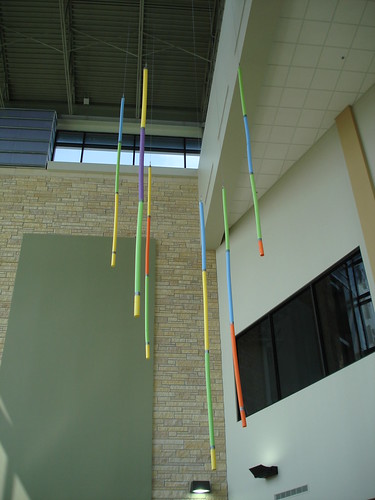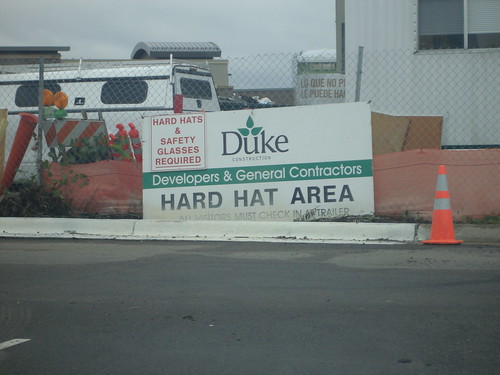CRYSTAL MESH from autokolor on Vimeo.
Temporary Manhattan art park
via Curbed.
It’s not entirely clear what will be happening here, but the basic idea is that while the property owner waits for the real estate market to revive, Lower Manhattan Cultural Council is working with architects Interboro Partners to create Lentspace, a temporary public park and exhibition with event programming. Excellent.
“LentSpace’s landscape design features a tree nursery that provides shade while incubating street trees to be planted throughout the downtown neighborhood at a later date. In addition, a custom operable fence opens the space to encourage a variety of social encounters, incorporating benches for seating and a display surface for a c ommissioned graphic design series. LentSpace is a free outdoor cultural space open to the public from 7am to dusk, made possible by LMCC.”
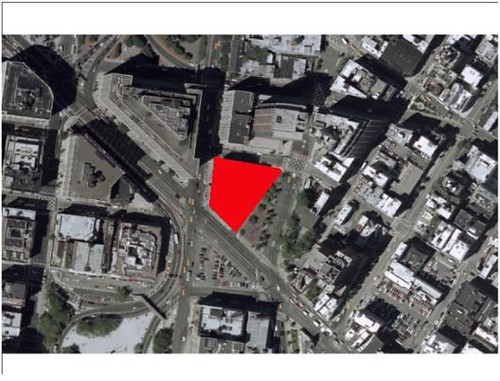
Who woulda thunk that Canal and Sixth would become the greenest intersection in town? Photo: Curbed.
The visual arts exhibition curated by LMCC’s curator Adam Kleinman includes work by artists: Olivier Babin, Olga Chernysheva, Eli Hansen & Oscar Tuazon, Graham Hudson, Tobias Putrih, Ryan Taber, and Corban Walker. Opening September 18.
Artful public pissoir

The City of Victoria unveiled this new public urinal on Friday. It was designed by Vancouver architect Matthew Soules. Sept. 5, 2009. Photo: CTV.ca
“The urinal is surrounded by about 150 vertical steel green pipes that have been welded together in a curvy design that is meant to evoke the arches in Victoria’s historic buildings, [architect Matthew] Soules said.
“The pipes are spaced apart just enough to let an outsider know if the urinal is being used but still maintain privacy for the user.”
Ars Electronica.3
5 September 2009
It rained Friday in Linz, so it was a good day to go indoors. I headed for the new Ars Electronica Center for my longest visit so far. The glass and steel extension to the original building, designed by Treusch Architecture of Vienna, was opened earlier this year. Inside the building are extensive exhibition areas for contemporary and historical new media work. The Future Lab facilities contain laboratories and workshops for media art research, with offices and recreation rooms above. The main building also has a restaurant, bar and lecture rooms on its Sky Deck.

Ars Electronica Center. Photo: Rupert Steiner
The Ars Electronica Center has a sculptural presence. It is meant to be viewed at various distances from diverse vantage points and is easy to traverse on foot. Set alongside the Danube River, its shape evokes a cargo ship. The long prow serves as a public performance or gathering space with raked stairs for seating. The building’s overall grid of glass and its double facade give it a crystalline appearance.

Ars Electronica Center, Linz, Austria. Photo: Bruce Charlesworth
The glass exterior is part transparent and part translucent. At night, LED panels installed between the two layers of the facade illuminate the building. Each panel contains nine sets of four LEDs: red, green, blue and white. These are set vertically, one in each window, alternately facing left and right. Each window functions much like a pixel in a digital image and can be individually controlled to allow infinite variations in color, intensity and duration.

Ars Electronica Center, Linz, Austria. Photo: Bruce Charlesworth
I attended a lecture on the facade and learned that there are 40,000 LEDS, 2,000 meters of cable and 5,100 square meters of glass comprising 1,085 windows. An average window contains 36 LEDs. The building also has a powerful sound system.
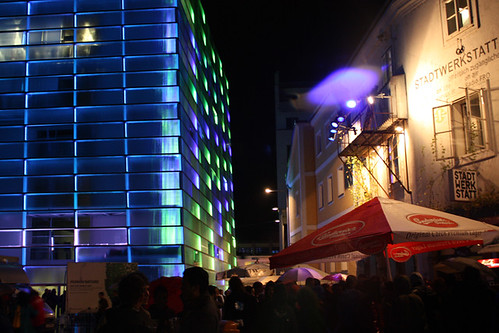
Ars Electronica Center, Linz, Austria. Photo: Bruce Charlesworth
Both sound and lighting can be programmed to create unique artworks on the facade, utilizing blended color, patterns, text and imagery. 84 artists have already created programs for the building, only three of which were commissioned works. AEC makes proposing and designing for the building fairly easy. Artists can construct their work using a 3D rendering of the facade, available on the Center’s Future Lab website, without ever having to visit the site in Linz.
Here’s a test visualization of the building lighting done last year.
Success!

Camille Utterback and Alan H. Davidson installing touch sensitive handrail for interactive light work.
Over the past week, Camille Utterback has been installing her as-yet-untitled (suggestions?) interactive sculptural artwork for the lobby of the Showplace Theaters in The West End, St. Louis Park, MN. It’s all working!

Camille Utterback, untitled interactive artwork, The West End, St. Louis Park, MN
There are 6 tubes with LED lights hanging over the staircase in the lobby of the theater. The LEDs react to people touching the handrails along the balcony. Each touch of a hand rail creates an upward “blip” in the corresponding LED light, which is the color of the rail at that moment. The length of the blip is determined by the duration of touching the rail. If all 6 rails are touched simultaneously, the lights rain down blips.
Camille Utterback, untitled interactive sculpture, The West End.
The balcony railing still needs to be stained, so the touch sensitive sections will not be permanently installed till next week, but it’s all working and ready of for the opening of The West End, which will begin in stages after September 15.
See Alan H. Davidson’s excellent documentation on flickr and previous posts on Public Address.
Ars Electronica.2
4 September 2009
Rain in Linz. Doesn’t bode well for some of the outside events today & tomorrow. These include Blast Theory’s Rider Spoke, a kind of wifi hide-and-seek for bicyclists equipped with handheld computers… and FLUT by Visualisierte Linzer Klangwoke, in which the city will be allegorically flooded and overrun with fantastic beasts. The allegory may turn literal if it keeps pouring.
Light sprinkles and overcast skies last night didn’t deter Sternennacht, during which lights were turned off in Hauptplatz (the central square in Linz) in order to better see the night sky. This is a great cooperative idea for a city. Unfortunately, stars were not visible, and any contemplative mood that might have resulted from the lack of light pollution was destroyed by what appeared to be the Austrian radio equivalent of Regis and Kathy Lee: an incessant happy chat session in a red-lighted tent.
On the other side of the square several people dressed in color-coded mime outfits were rotating and revolving in slow motion. I think they were supposed to be the planets, although there were more than eight (or nine, if you count Pluto). An older bearded guy in an orange jumpsuit and headlamp was clearly playing the Sun.
I revisited 80+1 Eine Weltreise/A Journey Around the World, housed in a striking mirrored structure nearby. Inside the wide opening of the 80+1 Base Camp are several networked pieces done over great distances. Included is a piece by the Chinese group 8GG interactive (Fu Yu, Jia Haiqing), in which air is “blown” from Beijing to Linz. Someone blowing into a recess in Beijing triggers a fan that conveys the smell of “spicy hotpot.” I wish this piece worked both ways, and the time distance makes for a sporadic experience. A more successful work, Digitie by Marianne Schmidt, allows you to insert your hand as someone at the Ars Electronica Center across the Danube does the same. Both hands are projected simultaneously. I was able to virtually stroke someone’s palm.
Another notable work in 80+1 is a photo-booth hookup to Bhutan, Grand Mutual Smiles by Australian Pierre Proske, based on the King of Bhutan’s pronouncement that “Gross National Happiness is more important than Gross National Product.” A Second Life setup seemed to be nothing more than SL as-is. I transported the very basic-looking default avatar to a popular English-speaking Welcome Area to see what would happen when other users got on the keyboard, but nothing more exciting ensued than physical collisions with avatars of Area regulars.
Additional information is available on 80+1‘s website,
Also in Hauptplatz is Japan Game in the Mobiles Oe1 Atelier, a white plastic geodesic dome. Inside are highlights from the Japan Media Arts Festival. Here you can try out a number of new Japanese game designs and witness for yourself how much contemporary media art utilizes the game paradigm.
Art for ransom

Art for Ransom. A project developed at the student design competition put on by the Art Directors Club of Denver.
An interesting twis on the various citywide mascot sculptures of: moose, angels, cows, rockfish, pigs, sharks, and … umbrellas.
And…
Bruce Charlesworth at Ars Electronica
[All this week, artist Bruce Charlesworth will be reporting from Ars Electronica.-SD]
3 Sept 2009
For me, events at Ars Electronica 2009 began last night with a presentation at the Lentos Kunstmuseum by multi-disciplinary American artist Tony Conrad. Best known for his 1966 film The Flicker (which I saw in its mind-bending 16mm entirety, back in grad school), Conrad appeared in conversation with Chris Salter and talked about his interest in the margins between picture and sound.
Conrad performed his Bowed Film, an instrument made from a length of film spliced into a kind of lasso. This he looped over his head, the long end tethered to the floor, and played with a violin bow. Normally this would be a private experience executed by one person and heard on headphones. Last night Conrad attached pickups to the instrument so that we could hear, too.

Ronnieism, performed by DJ Colette. Photo: Bruce Charlesworth
Later in the evening I went to the Grand Cafe zum Rothen Krebsen in Linz to see Ronnieism, performed by Ronnie Deelen. The small crowd was treated to a funhouse fusion of live-controlled music and video, composed on Gameboys and played on an instrument made of fifteen small stuffed toy animals.
Openings today in Linz include the new Ars Electronica Center, the CyberArts Exhibition at OK Offenes Kulturhaus and Human Nature at Brucknerhaus. More about these events tomorrow.
[updated 09.06.09]
American Institute Of Architects 2009 Housing Award
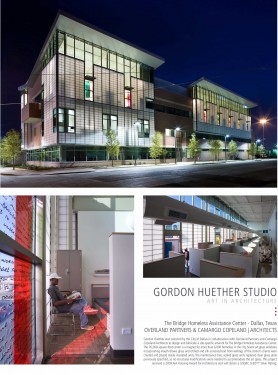
The Bridge Homeless Assistance Center with public art by Gordon Huether receives an American Institute Of Architects (AIA) 2009 Housing Award.
The Bridge Homeless Assistance Center in Dallas, Texas was developed from a reclaimed industrial warehouse opened in May 2008.
It is a multi-purpose facility dedicated to serving homeless men, women and children, with a primary focus on the chronically homeless. The artist worked with the homeless to create seven art glass windows incorporating brightly colored mouth-blown glass, etched and silk-screened with text from writings of the shelter’s clients. The text is superimposed over the glass panels.
Dry run with funnoodles
On Monday, Camille used some “funnoodles” to mock up final location of her interactive lighting installation in the theater at the new West End development.
More pictures here.
Today they install the real thing.
The Fourth Plinth Webcam
The Forth Plinth is a rotating public exhibition space in London. After sitting vacant for over 100 years the mayor of London took responsibility over Trafalgar Square in 1999 and created the Fourth Plinth Commissioning Group to select leading artists to create site specific work for the unused Plinth.
The current installation is by Antony Gormley famous for his use of the human form in gallery and public art installations.

View of Event Horizon part of Antony Gormley Blind Light at The Hayward. Photo copyright Gautier Deblonde
For Gormley’s Plinth installation he again reverts back to the human form but this time attempts to create a “living monument” in his project One and Other.
Every hour, 24 hours a day, for 100 days without a break, different people will make the Plinth their own. If you’re selected, you can use your time on the plinth as you like – to demonstrate, to perform, or simply to reflect. One & Other is open to anyone and everyone from any corner of the UK. As long as you’re 16 or over and are living, or staying, in the UK, you can apply to be part of this unforgettable artistic experiment. Participants will be picked at random, chosen from the thousands who will enter, to represent the entire population of the UK. The rules are simple: you must stand on the plinth alone, for the whole hour; you can do whatever you want, provided it’s legal; and you can take anything with you that you can carry.
via One & Other
But the best part of this website is the live webcam for those of us who want to experience the fun from afar!
The project will be “on view” until October 14th.
Installing at West End
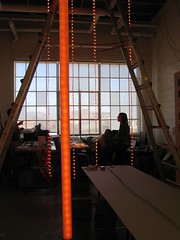
Camille Utterback, West End project (studio). "Studio before we sent out the lights. The lights are 'naked' as all but one test acrylic tube had already been shipped."
Camille Utterback begins installation of her West End project today. I’m excited to go visit and see the installation. They plan to hang some styrofoam pool “funnoodles” as a mockup to lock in the column heights/locations.
Here’s a link to a set of photos from a site visit last week checking out the wood railing by Utterback’s collaborator, Brett, who did the engineering on the project.
The Commons
“In this innovative animation, filmmaker Laura Hanna, writer Gavin Browning and video artists/animators Dana Schechter and Molly Schwartz examine the concept of “The Commons†as a means to achieve a society of justice and equality.”
via Postcapital
“Postcapital” is Daniel Garcia Andujar’s blog for his project Postcapital Archive (1989-2001), which will be part of the exhibition FEEDFORWARD: The Angel of History, which I am co-curating with Christiane Paul and opens at LABoral Art and Industrial Creation Centre on October 22.
Get your REFUNC on
REFUNC is a Netherlands-based studio.
“Garbage architecture is providing a second life for found or thrown-away objects. We operate on the borders of architecture, art and design and create new products from old materials. Origin for designs are found in the object itself, by listening to its own composition, history, or local and social context. We do not start from a design, we need a problem to play with. 3D troubleshooting and creative improvisation with the locally available. Waste materials lead the way to our often unpredictable results. Wherever you can find garbage, we do research and workshops on creative recycling.”
“We found a place in Holland where not usable windmill wings (for their intended function) were stored and felt that we needed to reuse them. Our idea to create an almost-flying dinosaur-installation in combination with containers hit the Lowlands music festival people on the right place as they are going more industrial.”
“[F]loating architectural installation to promote the river and its banks as active public spaces Lithuanian cultural platform KULTFLUX invited a group of international students and organized different workshops at and on the river. Intention was to draw attention and activate the river as public space including its banks and concrete promenades.”
“A public event wanted to follow the principles of “cradle to cradle” and asked us to demonstrate the potential of re-using old plastic water bottles.”
“[U]rban scale light installation for music festival lowlands from re-used watertanksanother year another chance. We decided to use the 240 water tanks from our last year’s installation in a completely different way.”
“Installation camp based on interaction with the direct context at the burning man regional festival in the desert. materialsUsed car tires from nearest tire shops, transport. Left-over materials from other installations as wood, plastic.”
Secret public spaces
“Instant Coffee is well known for its relational aesthetics approach to art-making, in which loosely defined social scenarios invite an art experience that blurs the boundaries between artist, participant and viewer. With Disco Fallout Shelter, the group has purposely turned the tables on that all-inclusive mode of working. Instead, the locked doors and mysterious subterranean workings are designed to be overtly exclusive. Sounds emanating from below ground suggest that the spartan interior of a bomb shelter has been transformed into a signature Instant Coffee party centre. This time, though, the catch is that only members of the collective are invited to the artful merrymaking. Viewers can ‘participate’ via an above-ground video kiosk showing (pre-recorded) footage of members ‘playing records, eating spaghetti, dancing, reading, sleeping and just hanging out in the tight confines and under the protective barrier of shelter.'”
via Canadian Art
The inaccessible secret space in a public location also reminds me of Atelier Lishout’s The Good the Band and the Ugly (1998), which was in the Minneapolis Sculpture Garden for many years.

"the good, the bad, and the ugly" mobile unit, © atelier van lieshout, 1998 collection walker art center, minneapolis
“The project has two parts. The aluminum and fiberglass trailer, the Art Lab on wheels, which is modern, progressive and technologically advanced. As a space, it is as neutral and flexible as possible. It will allow the users to make it their own space, far from the artist or the institution’s dictate. One could say that the trailer is the pure execution of the commission for the client, the Walker Art Center.”
“The black wooden house would be his fantasy, an addition useful for residencies, workshops that stays fixed in the garden. This house could be seen as coming from both the tradition of the pioneer shelter, as well as a kind of mythic movie architecture– a place built out of necessity by a group of friends. The house, like the trailer, is real. It is wired and furnished. Joep van Lieshout modeled the bed, chairs, table and shelves, after Shaker furniture design. The house has secret places, dark corners and in a way is like the killer’s house in Jonathan Demme’s Silence of the Lambs. This would be the ‘bad and ugly’ part of the project. The trailer would be the good part.”







